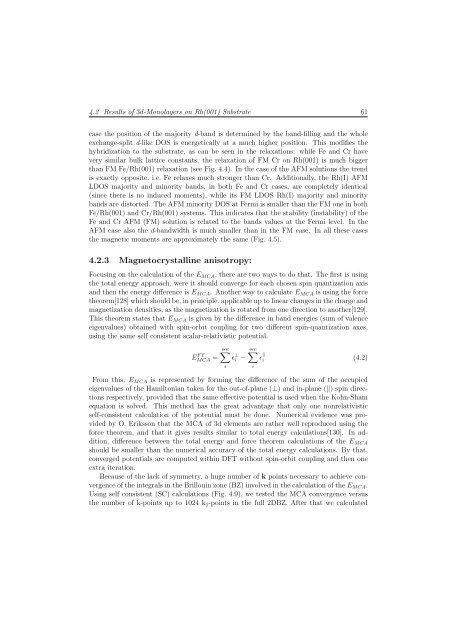Ab initio investigations of magnetic properties of ultrathin transition ...
Ab initio investigations of magnetic properties of ultrathin transition ...
Ab initio investigations of magnetic properties of ultrathin transition ...
You also want an ePaper? Increase the reach of your titles
YUMPU automatically turns print PDFs into web optimized ePapers that Google loves.
4.2 Results <strong>of</strong> 3d-Monolayers on Rh(001) Substrate 61<br />
case the position <strong>of</strong> the majority d-band is determined by the band-filling and the whole<br />
exchange-split d-like DOS is energetically at a much higher position. This modifies the<br />
hybridization to the substrate, as can be seen in the relaxations: while Fe and Cr have<br />
very similar bulk lattice constants, the relaxation <strong>of</strong> FM Cr on Rh(001) is much bigger<br />
than FM Fe/Rh(001) relaxation (see Fig. 4.4). In the case <strong>of</strong> the AFM solutions the trend<br />
is exactly opposite, i.e. Fe relaxes much stronger than Cr. Additionally, the Rh(I) AFM<br />
LDOS majority and minority bands, in both Fe and Cr cases, are completely identical<br />
(since there is no induced moments), while its FM LDOS Rh(I) majority and minority<br />
bands are distorted. The AFM minority DOS at Fermi is smaller than the FM one in both<br />
Fe/Rh(001) and Cr/Rh(001) systems. This indicates that the stability (instability) <strong>of</strong> the<br />
Fe and Cr AFM (FM) solution is related to the bands values at the Fermi level. In the<br />
AFM case also the d-bandwidth is much smaller than in the FM case. In all these cases<br />
the <strong>magnetic</strong> moments are approximately the same (Fig. 4.5).<br />
4.2.3 Magnetocrystalline anisotropy:<br />
Focusing on the calculation <strong>of</strong> the EMCA, there are two ways to do that. The first is using<br />
the total energy approach, were it should converge for each chosen spin quantization axis<br />
and then the energy difference is EMCA. Another way to calculate EMCA is using the force<br />
theorem[128] which should be, in principle, applicable up to linear changes in the charge and<br />
magnetization densities, as the magnetization is rotated from one direction to another[129].<br />
This theorem states that EMCA is given by the difference in band energies (sum <strong>of</strong> valence<br />
eigenvalues) obtained with spin-orbit coupling for two different spin-quantization axes,<br />
using the same self consistent scalar-relativistic potential.<br />
E FT<br />
MCA =<br />
�occ<br />
i<br />
ɛ ⊥ �occ<br />
i −<br />
i<br />
ɛ �<br />
i<br />
(4.2)<br />
From this, EMCA is represented by forming the difference <strong>of</strong> the sum <strong>of</strong> the occupied<br />
eigenvalues <strong>of</strong> the Hamiltonian taken for the out-<strong>of</strong>-plane (⊥) and in-plane (�) spin directions<br />
respectively, provided that the same effective potential is used when the Kohn-Sham<br />
equation is solved. This method has the great advantage that only one nonrelativistic<br />
self-consistent calculation <strong>of</strong> the potential must be done. Numerical evidence was provided<br />
by O. Eriksson that the MCA <strong>of</strong> 3d elements are rather well reproduced using the<br />
force theorem, and that it gives results similar to total energy calculations[130]. In addition,<br />
difference between the total energy and force theorem calculations <strong>of</strong> the EMCA<br />
should be smaller than the numerical accuracy <strong>of</strong> the total energy calculations. By that,<br />
converged potentials are computed within DFT without spin-orbit coupling and then one<br />
extra iteration.<br />
Because <strong>of</strong> the lack <strong>of</strong> symmetry, a huge number <strong>of</strong> k points necessary to achieve convergence<br />
<strong>of</strong> the integrals in the Brillouin zone (BZ) involved in the calculation <strong>of</strong> the EMCA.<br />
Using self consistent (SC) calculations (Fig. 4.9), we tested the MCA convergence versus<br />
the number <strong>of</strong> k-points up to 1024 k�-points in the full 2DBZ. After that we calculated

















